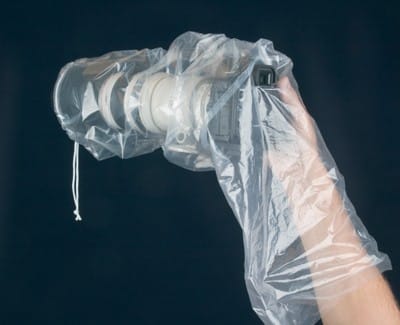Protect Your Camera in the Rain

It’s not just sunny days that lead to sumptuous photos. Rain can serve photography lovers too, but you need be careful to keep it a good servant, not a cruel master. If rain gets inside your camera, that’s going to be an expensive repair. So read up today on how to overcome rain’s perils and how to protect your camera from water.
How Waterproof Is Your Camera?
Typical cameras aren’t made for downpours, but a few raindrops won’t hurt them. But keep in mind that when you shoot in the rain, you shoot at your own risk. If you try to claim warranty on rain damage, you’ll be laughed out of the shop. The more expensive your camera, the more likely it is that you won’t see any damage at all.
But even the highest camera lines are officially only vaguely labeled as “weather sealed,” with no further details. In practice that means that many of its welds, joints, and doors have seals to increase their resistance. But none of it is guaranteed.

The same applies for lenses. Some have no seals, some have a few, some have more. More seals equals less risk when a lens is used in the rain. Even though it may seem like a lens—especially a zoomless lens—is quite a solid object, the focus rings can conceal mounting points, which are holes that will let in water easily. The picture here shows focus rings that the manufacturer has covered up with clear tape, but that’s an exception.

I tried shooting in a light rain with a rickety old Canon 350D and the most basic of lenses, and no harm was done. I’ve seen a Canon 5D Mark II and 5D Mark III survive a much worse rainstorm, even though at points the rain fell so thick that I could hardly see the LCD. Moments like these make a fellow appreciate the 5D’s protected viewfinder and its dedicated buttons for individual functions, which mean you don’t have to dig in menus. But Lady Luck is fickle. For example, a friend of mine had his 5D Mark III damaged so badly by water that he had to spend a fortune in the repair shop.
There are also cameras that are actually made for the rain, or at least for bad weather—like the GoPro Hero, the Canon PowerShot D10, and the Nikon Coolpix AW300—but these are exceptions, and they pay for this toughness with disadvantages elsewhere.
Protecting Your Camera
If you’re going to be spending a long time under the rain, there are ways to shield your expensive electronics. Underwater shields are expensive, but thankfully when it comes to rain, they’re also pointless. Besides the very simplest variant—a friend holding an umbrella over you—you can also wrap your camera in plastic.
You can either improvise and create your own cover, or buy a pre-made “sleeve” with the right shape. There are a lot of them out there, to fit a lot of sizes and a lot of lenses.

Lens Hoods
Now you’ve got the camera body covered, but what about the front? Although rain can’t penetrate the front glass of the lens, water drops will blur the image. That’s where lens hoods—typically used as sun shields—come in.
Telephoto lenses have an advantage here, with their deep lens hoods. Wide lenses, meanwhile, have shallow lens hoods that don’t help against the rain. Because of this, rainy-day photos typically have long focal lengths.

Bags and Backpacks
An ordinary backpack or any other home for a camera can handle a lot of rain. But if you need to hold out in the rain a long time (for example a day-long tour out in the rain, out in the open), then look for something that comes with a jacket. Camera backpacks often come with these, as do bags and cases. Although this means more difficult access to your gear, it also means it will stay safely dry for most of the trip.
But for a short rainfall, you can skip the jacket. Personally I’ve only needed this solution once.

Clothing
Obviously if you’re heading out into the rain, you’ll appreciate a waterproof jacket and good shoes. The extra comfort makes for a nicer shoot. But I have a tip on top of that, about lens covers.
Personally I’m used to carrying my lens cover in my pocket, but when it’s hot and humid, there’s a problem with that. When the cover is stuffed against your body (even indirectly, through your pocket), moisture condenses on it. And then when you put it back on your lens, you can get water drops on the lens, or a foggy lens. It’s an extreme, but I’ve seen it.
The solution is simple—I still carry lens covers in my pocket, but I carry them with the inner side facing away from my body. And I double-check them before putting them back on.
Make It Last
We hope that these tips help you out and that your next trip in the rain brings no nasty surprises, and instead of worrying about your camera, you’ll be able to focus on great pictures.